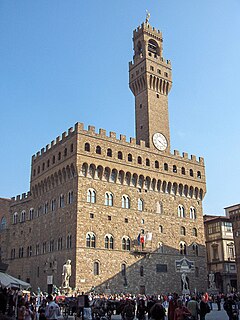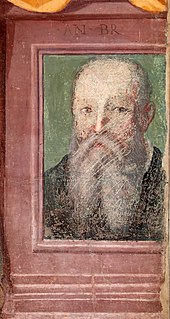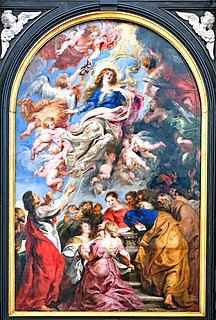History
The painting was commissioned by Bartolomeo Panciatichi (the Elder) for a private altar in the French church of Notre-Dame-de-Confort, in Lyon; however, when finished, it remained in Italy. It was subsequently acquired by Bartolomeo Panciatichi the Younger, the man later portrayed by Agnolo Bronzino. In 1526 Andrea del Sarto used the same composition in the Passerini Assumption , now housed in the same museum. Later, Bartolomeo gifted the work to Jacopo Salviati, who moved it to his villa del Poggio Imperiale. After all Salviati's possessions were confiscated by Duke Cosimo I de' Medici, the villa and all its content went to Paolo Giordano Orsini, husband of the duke's daughter Isabella d'Este.
After several changes of property, including a period under the Odescalchi, the villa returned to the Medici family in 1602. In 1687 it was decided to the move the Assumption to Pitti Palace, as part of the collection of prince Ferdinando de' Medici. The panel was enlarged in that occasion, in order to mount the same frame of the Passerini Assumption , also taken to the palace.
Description
The work depicts the theme of the Assumption of Mary with two registers: the lower one shows the apostles of Jesus crowding around Mary's empty sepulcher, looking at her while she ascends to heaven in a cloud in the upper part, surrounded by happy puttoes. Andrea del Sarto painted two kneeling apostles in the middle, according to the traditional pyramidal composition of holy Conversations, joining them to a circle of other apostles which can be seen, for example, in Raphael's Oddi Altarpiece.
The presence of a grotto at the right is unusual. Mary is looking upwards, surrounded by a celestial light . At her sides are two symmetrical groups of angels, whose tables perhaps were intended to contain the artist's signature, the donor's name and the execution year; another, in the middle, calls the apostles' attention towards Mary.
Some of the characters were perhaps portraits of existing people. The apostle kneeling and looking towards the seer, for example, is sometimes identified as Andrea del Sarto's self-portrait.

Alessandro di Cristofano di Lorenzo del Bronzino Allori was an Italian portrait painter of the late Mannerist Florentine school.

Franciabigio was an Italian painter of the Florentine Renaissance. His true name may have been Francesco di Cristofano, however he also is referred to as either Marcantonio Franciabigio or Francia Bigio.

The Palazzo Vecchio is the town hall of Florence, Italy. It overlooks the Piazza della Signoria, which holds a copy of Michelangelo's David statue, and the gallery of statues in the adjacent Loggia dei Lanzi.

The Palazzo Pitti, in English sometimes called the Pitti Palace, is a vast, mainly Renaissance, palace in Florence, Italy. It is situated on the south side of the River Arno, a short distance from the Ponte Vecchio. The core of the present palazzo dates from 1458 and was originally the town residence of Luca Pitti, an ambitious Florentine banker.

Agnolo di Cosimo, usually known as Bronzino or Agnolo Bronzino, was an Italian Mannerist painter from Florence. His sobriquet, Bronzino, may refer to his relatively dark skin or reddish hair.
Villa del Poggio Imperiale is a predominantly neoclassical former grand ducal villa in Arcetri, just to the south of Florence in Tuscany, central Italy. Beginning as a villa of the Baroncelli of Florence, it was seized by the Medici, became the home of a homicidal and unfaithful husband, and a lavish retreat for a Grand Duchess with imperial pretensions. Later given to Napoleon's sister, it was reclaimed by the hereditary rulers of Tuscany before being finally converted to a prestigious girls' school. During its long history, it has often been at the centre of Italy's turbulent history, and has been rebuilt and redesigned many times.

Justus Sustermans, Joost Sustermans or Suttermans, his given name Italianised to Giusto, was a Flemish painter and draughtsman who is mainly known for his portraits. He also painted history and genre paintings, still lifes and animals.

Ridolfo di Domenico Bigordi, better known as Ridolfo Ghirlandaio was an Italian Renaissance painter active mainly in Florence. He was the son of Domenico Ghirlandaio.

The Assumption of the Virgin Mary does not appear in the New Testament, but appears in apocryphal literature of the 3rd and 4th centuries, and by 1000 was widely believed in the Western Church, though not made formal Catholic dogma until 1950. It first became a popular subject in Western Christian art in the 12th century, along with other narrative scenes from the Life of the Virgin, and the Coronation of the Virgin. These "Marian" subjects were especially promoted by the Cistercian Order and Saint Bernard of Clairvaux.

Francesco de' Rossi was an Italian Mannerist painter who lived and worked mainly in Florence, but also produced several works in Rome. He is known by many names, prominently the adopted name Francesco Salviati or as Il Salviati, but also Francesco Rossi and Cecchino del Salviati.

Francesco d'Ubertino Verdi, called Bachiacca. He is also known as Francesco Ubertini, il Bacchiacca (1494–1557). He was an Italian painter of the Renaissance whose work is characteristic of the Florentine Mannerist style.

Anton Domenico Gabbiani was an Italian painter and active in a late Baroque style.

Andrea del Sarto was an Italian painter from Florence, whose career flourished during the High Renaissance and early Mannerism. He was known as an outstanding fresco decorator, painter of altar-pieces, portraitist, draughtsman and colorist. Though highly regarded during his lifetime as an artist senza errori, his renown was eclipsed after his death by that of his contemporaries, Leonardo da Vinci, Michelangelo and Raphael.

The Lamentation over the Dead Christ is a painting of the common subject of the Lamentation of Christ by the Italian Renaissance painter Pietro Perugino, executed in 1495 and now in the Galleria Palatina of Palazzo Pitti, Florence, Italy.

The Portrait of Alvise Cornaro is a portrait by the Venetian painter Tintoretto, showing the man of letters Alvise 'Luigi' Cornaro. Datable to around 1560–1565, it was acquired by Leopoldo de' Medici and is now in the Galleria Palatina in Florence. For the time between the 1698 and 1829 inventories, it was mis-attributed to Titian.

Passerini Assumption is a painting by Italian Renaissance artist Andrea del Sarto, painted in 1526. It is housed in the Galleria Palatina of Palazzo Pitti, Florence, Italy.

Bartolomeo Panciatichi (1507-1582) was an Italian humanist and politician.

Assumption of the Virgin is a fresco by Rosso Fiorentino in the Chiostro dei Voti of the Basilica della Santissima Annunziata in Florence.

Saint John the Baptist as a Boy is an oil on panel painting by Andrea del Sarto, executed c. 1525, now in the Palatine Gallery of the Palazzo Pitti in Florence.

















